Inside The New York Botanical Garden
book review
Posted in From the Library on September 18 2017, by Esther Jackson
Esther Jackson is the Public Services Librarian at NYBG’s LuEsther T. Mertz Library where she manages Reference and Circulation services and oversees the Plant Information Office. She spends much of her time assisting researchers, providing instruction related to library resources, and collaborating with NYBG staff on various projects related to Garden initiatives and events.
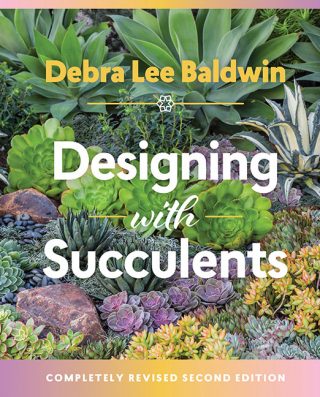 As I browsed Designing with Succulents, recently published in its revised second edition by Debra Lee Baldwin for Timber Press, I attracted some attention. “I love succulents,” multiple co-workers informed me, looking longingly at Baldwin’s book. After encouraging them to check out the library’s copy, I went back to my reading for this review. I have to agree with my coworkers. I love succulents! I love caring for my small houseplant collection as well as seeing ambitious and riotous garden designs and plantings that feature these plants.
As I browsed Designing with Succulents, recently published in its revised second edition by Debra Lee Baldwin for Timber Press, I attracted some attention. “I love succulents,” multiple co-workers informed me, looking longingly at Baldwin’s book. After encouraging them to check out the library’s copy, I went back to my reading for this review. I have to agree with my coworkers. I love succulents! I love caring for my small houseplant collection as well as seeing ambitious and riotous garden designs and plantings that feature these plants.
Succulents are appealing for many reasons including their bright, bold colors, use in low-water landscapes, and relatively low-maintenance as both house and garden plants. In her new book, Baldwin scintillates those who are already succulent enthusiasts and inspires those who have dreamed about growing succulents but haven’t yet taken the plunge.
Read More
Posted in From the Library on August 17 2017, by Esther Jackson
Esther Jackson is the Public Services Librarian at NYBG’s LuEsther T. Mertz Library where she manages Reference and Circulation services and oversees the Plant Information Office. She spends much of her time assisting researchers, providing instruction related to library resources, and collaborating with NYBG staff on various projects related to Garden initiatives and events.
 Montana’s Pioneer Botanists: Exploring the Mountains and Prairies is a new book from editors Rachel Potter and Peter Lesica, with an introduction by Jack Nisbet.
Montana’s Pioneer Botanists: Exploring the Mountains and Prairies is a new book from editors Rachel Potter and Peter Lesica, with an introduction by Jack Nisbet.
Montana’s Pioneer Botanists, a collection of biographies of regional botanists working in Montana, is the type of book that I really enjoy. Collections like this are essential for documenting and remembering important regional workers while sharing their legacy with the world. As is the case with other books of this ilk, some of the figures profiled in Montana’s Pioneer Botanists are known to a wider audience (Meriwether Lewis, for example), while others are beloved local heroes. In his introduction, Nisbet writes, “The subjects here hold a keen awareness of those who came before them, lending a strong sense of continuity to the entire project.” This continuity travels beyond Montana documenting ties between Montana botanists and the wider world, including the New York Botanical Garden. For example, botanist Robert Statham Williams (1859-1945) collected plants in Montana for years before joining the New York Botanical Garden in 1899. John Leiberg (1853-1913), another botanist profiled in this work, was a correspondent of Elizabeth Britton throughout his career.
Read More
Posted in From the Library, Shop/Book Reviews on February 6 2017, by Esther Jackson
Esther Jackson is the Public Services Librarian at NYBG’s LuEsther T. Mertz Library where she manages Reference and Circulation services and oversees the Plant Information Office. She spends much of her time assisting researchers, providing instruction related to library resources, and collaborating with NYBG staff on various projects related to Garden initiatives and events.
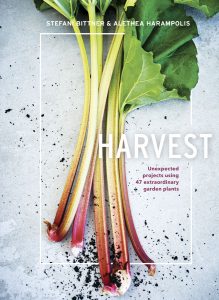
Harvest: Unexpected projects using 47 extraordinary garden plants is a delightful new book from Ten Speed Press. This is the fourth book from author pair Stefani Bittner and Alethea Harampolis whose other titles include The Beautiful Edible Garden, Branches & Blooms, and The Flower Recipe Book. Harvest contains projects related to cooking, craft beverages, beauty care, decorations for the home, and flower arranging. Beautiful photographs by David Fenton accompany the projects. With plants and projects divided into three growing seasons, early (late winter to spring), mid (summer to early fall), and late (late fall to early winter), the book is an eclectic mix of inspiring ideas and ethereal photographs.
Read More
Posted in From the Library on January 30 2017, by Esther Jackson
Esther Jackson is the Public Services Librarian at NYBG’s LuEsther T. Mertz Library where she manages Reference and Circulation services and oversees the Plant Information Office. She spends much of her time assisting researchers, providing instruction related to library resources, and collaborating with NYBG staff on various projects related to Garden initiatives and events.
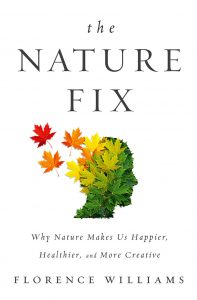 Why do some of us feel happier, healthier, more relaxed, or more energized by nature? Why does an isolated hike in the woods illicit strong feelings of contentment, while a walk in an urban green space devoid of trees fails to inspire the same feelings? Different people have different reactions to time spent in nature, of course, but why do we have reactions at all? Why are some people more affected than others by a babbling brook or a coniferous forest? With these big, somewhat subjective questions in mind, Florence Williams sets out on a journey to find and share answers in The Nature Fix: Why Nature Makes Us Happier, Healthier, and More Creative. The mix between personal and academic voice can be a tough thing for an author to navigate, but Williams accomplishes this hybridity with great skill.
Why do some of us feel happier, healthier, more relaxed, or more energized by nature? Why does an isolated hike in the woods illicit strong feelings of contentment, while a walk in an urban green space devoid of trees fails to inspire the same feelings? Different people have different reactions to time spent in nature, of course, but why do we have reactions at all? Why are some people more affected than others by a babbling brook or a coniferous forest? With these big, somewhat subjective questions in mind, Florence Williams sets out on a journey to find and share answers in The Nature Fix: Why Nature Makes Us Happier, Healthier, and More Creative. The mix between personal and academic voice can be a tough thing for an author to navigate, but Williams accomplishes this hybridity with great skill.
Williams, like other popular science writers, brings readers along for the journey as she researches how different cultures or organizations scientifically quantify health benefits related to nature. Does that sound like a lot to cover in one book? It most certainly is. One of the great strengths of Nature Fix is that the author includes an enormous amount of cited scientific research alongside her more personal travelogue. She is also skilled with setting a scene for readers, providing descriptions that are both visual and engaging.
Read More
Posted in From the Library on January 25 2017, by Esther Jackson
Esther Jackson is the Public Services Librarian at NYBG’s LuEsther T. Mertz Library where she manages Reference and Circulation services and oversees the Plant Information Office. She spends much of her time assisting researchers, providing instruction related to library resources, and collaborating with NYBG staff on various projects related to Garden initiatives and events.
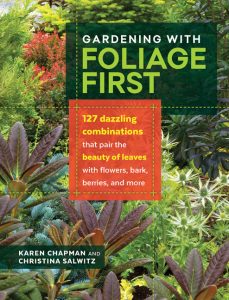 Gardening with Foliage First: 127 Dazzling Combinations That Pair the Beauty of Leaves with Flowers, Bark, Berries, and More is a recipe book for colorful and creative garden designs. The premise of the book is that flowers are lovely, but foliage is the longer-lasting ornament in a garden bed. For gardeners trying to create landscapes with year-round interest, starting with the foliage first is a wonderful approach.
Gardening with Foliage First: 127 Dazzling Combinations That Pair the Beauty of Leaves with Flowers, Bark, Berries, and More is a recipe book for colorful and creative garden designs. The premise of the book is that flowers are lovely, but foliage is the longer-lasting ornament in a garden bed. For gardeners trying to create landscapes with year-round interest, starting with the foliage first is a wonderful approach.
Authors Karen Chapman and Christina Salwitz “scoured gardens from British Columbia to Arizona and Florida to Washington State to find designs to delight, inspire, and embolden [readers] to try new ideas, new plants, and new ways of looking at plant combinations.” The resulting text is both beautiful and functional.
Read More
Posted in From the Library on January 9 2017, by Esther Jackson
Esther Jackson is the Public Services Librarian at NYBG’s LuEsther T. Mertz Library where she manages Reference and Circulation services and oversees the Plant Information Office. She spends much of her time assisting researchers, providing instruction related to library resources, and collaborating with NYBG staff on various projects related to Garden initiatives and events.
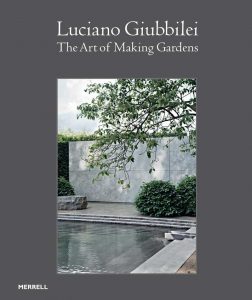 Luciano Giubbilei visited NYBG last year as one of the speakers in the 16th Annual Winter Lecture Series. Born in Siena, Italy, Giubbilei emigrated to London, England in 1994 to study at the Inchbald School of Design. In 1997 he established his own garden design practice, and over the past twenty years Giubbilei has been involved in a myriad of garden design projects and collaborations.
Luciano Giubbilei visited NYBG last year as one of the speakers in the 16th Annual Winter Lecture Series. Born in Siena, Italy, Giubbilei emigrated to London, England in 1994 to study at the Inchbald School of Design. In 1997 he established his own garden design practice, and over the past twenty years Giubbilei has been involved in a myriad of garden design projects and collaborations.
Giubbilei’s biography is a laundry list of laudable experiences, including three gold medals won at the Chelsea Flower Show in 2009, 2011, and 2014. In 2015 Andrew Wilson authored The Gardens of Luciano Giubbilei, a “testament to a life’s work in progress.” In 2016, Giubbilei followed up with his own book, The Art of Making Gardens.
Read More
Posted in From the Library on November 29 2016, by Esther Jackson
Esther Jackson is the Public Services Librarian at NYBG’s LuEsther T. Mertz Library where she manages Reference and Circulation services and oversees the Plant Information Office. She spends much of her time assisting researchers, providing instruction related to library resources, and collaborating with NYBG staff on various projects related to Garden initiatives and events.
 Half-Earth: Our Planet’s Fight for Life is the newest book from acclaimed biologist E. O. Wilson. In addition to Half-Earth, Wilson has authored dozens of books. Unsurprisingly, Half-Earth has echoes of Wilson’s other environmental works. With that in mind, this new book is still a very good stand-alone book about environmentalism, biology, and natural resources. It’s written accessibly both for those working in the sciences and for non-scientists who are eager to learn more about environmentalism and conservation. Half-Earth is ultimately quite philosophical, but includes the framework of a practical call to action.
Half-Earth: Our Planet’s Fight for Life is the newest book from acclaimed biologist E. O. Wilson. In addition to Half-Earth, Wilson has authored dozens of books. Unsurprisingly, Half-Earth has echoes of Wilson’s other environmental works. With that in mind, this new book is still a very good stand-alone book about environmentalism, biology, and natural resources. It’s written accessibly both for those working in the sciences and for non-scientists who are eager to learn more about environmentalism and conservation. Half-Earth is ultimately quite philosophical, but includes the framework of a practical call to action.
Wilson writes with great conviction, and Half-Earth is replete with wonderful passages in praise of science. This is a sobering yet useful book to read when so many science writers and others are touting the value of “novel ecosystems” and downplaying the problems associated with invasive species. Wilson doesn’t sugarcoat the challenges that the environment currently faces—the Earth is in trouble in many ways, overpopulation not the least of its worries. There are no simple solutions. The first step is to be educated and informed about the world around us.
Read More
Posted in From the Library, Shop/Book Reviews on October 24 2016, by Esther Jackson
Esther Jackson is the Public Services Librarian at NYBG’s LuEsther T. Mertz Library where she manages Reference and Circulation services and oversees the Plant Information Office. She spends much of her time assisting researchers, providing instruction related to library resources, and collaborating with NYBG staff on various projects related to Garden initiatives and events.
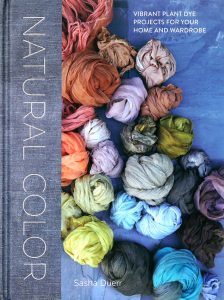 Natural Color: Vibrant Plant Dye Projects for Your Home and Wardrobe has the look of a book that is waiting to be touched. With its slightly-textured cover materials and luscious cover photo it draws the eye while subtlety hinting at the projects it contains. This book by Sasha Duerr, published with Ten Speed Press, builds in part off of her earlier publication The Handbook of Natural Plant Dyes which was published in 2010 with Timber Press.
Natural Color: Vibrant Plant Dye Projects for Your Home and Wardrobe has the look of a book that is waiting to be touched. With its slightly-textured cover materials and luscious cover photo it draws the eye while subtlety hinting at the projects it contains. This book by Sasha Duerr, published with Ten Speed Press, builds in part off of her earlier publication The Handbook of Natural Plant Dyes which was published in 2010 with Timber Press.
Natural Color opens with a gorgeous image of a passionflower (Passiflora edulis) photographed by Aya Bracket. Bracket’s photos coupled with precise and artistic page layouts make this book about practical handicraft a work of art in and of itself. Even those who have not dyed materials (and perhaps have no real desire to do so) can appreciate the beauty of this work. Duerr’s couching of her dyeing ethics within permaculture is both intriguing and accessible. One of the names associated with “slow fashion,” Duerr champions both self-sufficiency for people as well as respect for and harmony with the natural world. Many of the projects in Natural Color make use of cultivated garden plants, non-native plants that have become “weeds,” and plants that can be sustainably and responsibly harvested.
Read More
Posted in From the Library on September 19 2016, by Esther Jackson
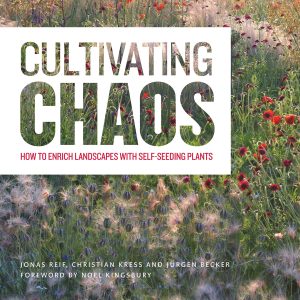 Organized chaos has its charms, as the authors of Cultivating Chaos: How to Enrich Landscapes with Self-Seeding Plants are eager to extol. There is both an anxiety and a freedom that comes with allowing garden plants to live out their life cycles unmolested—setting seeds and dropping them from cradle to grave and back again. In Chaos’s introduction, Noel Kingsbury writes of using self-seeding plants to establish and encourage a more full and vibrant ecological system in the garden. In the pages that follow, the authors take up this idea and expand upon the theme.
Organized chaos has its charms, as the authors of Cultivating Chaos: How to Enrich Landscapes with Self-Seeding Plants are eager to extol. There is both an anxiety and a freedom that comes with allowing garden plants to live out their life cycles unmolested—setting seeds and dropping them from cradle to grave and back again. In Chaos’s introduction, Noel Kingsbury writes of using self-seeding plants to establish and encourage a more full and vibrant ecological system in the garden. In the pages that follow, the authors take up this idea and expand upon the theme.
Part of embracing “chaos” in the garden requires letting go. When planting communities that are intended to be self-seeding, the gardener should, in theory, release some control. There might be a plan in mind, but there should also be a willingness to see what the plants do when left to their own devices. The gardener might only work to remove undesirable plants and to fill in gaps when different species die off.
Chaos has a great deal of practical advice for the home gardener. The book is divided into four sections, plus a resources section. “How do you garden with self-seeding plants?,” “Let the planting begin,” “Strategies for design and maintenance,” and “Plants for self-seeding gardens” take the home gardener through the process of using self-seeding plants from start to finish. Gorgeous photographs of different gardens adorn the book’s pages throughout the narrative.
Read More
Posted in From the Library on September 12 2016, by Esther Jackson
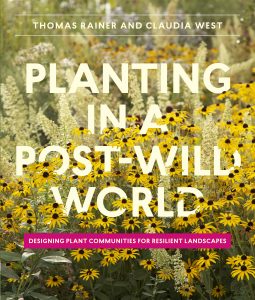 Sometimes one comes across a landscape design book that simply demands to be read from cover to cover without pause. Planting in a Post-Wild World is one such book. Part ecological manifesto, part how-to planting guide, and part artistic statement, Post-Wild is a wonderful and refreshing addition to the world of landscape and planting design literature.
Sometimes one comes across a landscape design book that simply demands to be read from cover to cover without pause. Planting in a Post-Wild World is one such book. Part ecological manifesto, part how-to planting guide, and part artistic statement, Post-Wild is a wonderful and refreshing addition to the world of landscape and planting design literature.
Thomas Rainer and Claudia West are co-authors of Post-Wild. Rainer is a registered landscape architect, teacher, and writer, and West is a landscape designer, lecturer, and consultant. Both work in the U.S., but in the evocative preface each writes of the very different beginnings of their understanding of the wild.
Read More
 As I browsed Designing with Succulents, recently published in its revised second edition by Debra Lee Baldwin for Timber Press, I attracted some attention. “I love succulents,” multiple co-workers informed me, looking longingly at Baldwin’s book. After encouraging them to check out the library’s copy, I went back to my reading for this review. I have to agree with my coworkers. I love succulents! I love caring for my small houseplant collection as well as seeing ambitious and riotous garden designs and plantings that feature these plants.
As I browsed Designing with Succulents, recently published in its revised second edition by Debra Lee Baldwin for Timber Press, I attracted some attention. “I love succulents,” multiple co-workers informed me, looking longingly at Baldwin’s book. After encouraging them to check out the library’s copy, I went back to my reading for this review. I have to agree with my coworkers. I love succulents! I love caring for my small houseplant collection as well as seeing ambitious and riotous garden designs and plantings that feature these plants. 








